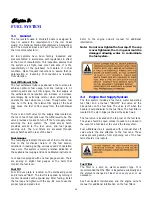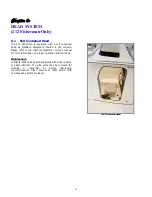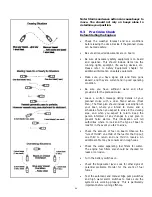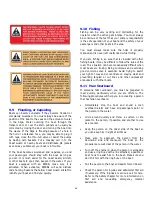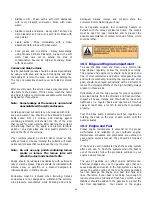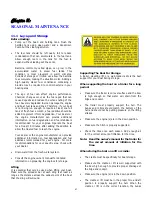
Chapter 9
OPERATION
9.1 General
Before you start the engines on your Wellcraft, you
should have become familiar with the various
component systems and their operation, and have
performed a “Pre-cruise System Check." A thorough
understanding of the component systems and their
operation is essential to the proper operation of the
boat. This manual and the associated manufacturers’
information is provided to enhance your knowledge of
your boat. Please read them carefully.
Your boat must have the necessary safety equipment on
board and be in compliance with the U.S. Coast Guard,
local and state safety regulations. There should be one
Personal Floatation Device (PFD) for each person. Non-
swimmers and small children should wear a PFD at all
times. You should know and understand the “Rules of
the Road" and have had an experienced operator brief
you on the general operation of your new boat. At least
one other person should be instructed on the proper
operation of the boat in case the operator is suddenly
incapacitated.
The operator is responsible for his safety and the safety
of his or her passengers. When boarding or loading the
boat, always step onto the boat, never jump. All
passengers should be properly seated whenever the
boat is operated above idle speed. Your passengers
should not be allowed to sit on the seat backs, gunnels,
bows, transoms or on fishing seats whenever the boat is
underway. The passengers also should be seated to
properly balance the load and must not obstruct the
operator's view, particularly to the front.
Overloading and improper distribution of weight can
cause the boat to become unstable and are significant
causes of accidents. Know the weight capacity and
horsepower rating of your boat. Do not overload or
overpower your boat.
You should be aware of your limitations and the
limitations of your boat in different situations or sea
conditions. No boat is indestructible, no matter how well
it is constructed. Any boat can be severely damaged if it
is operated in a manner that exceeds its design
limitations. If the ride is hard on you and your
passengers, it is hard on the boat as well. Always modify
the boat speed in accordance with the sea conditions,
boat traffic and weather conditions.
Remember, it is the operator's responsibility to
use good common sense and sound judgment in
loading and operating the boat.
9.2
Rules of the Road
As in driving an automobile, there are a few rules you
must know for safe boating operation. The following
information describes the basic navigation rules and
action to be taken by vessels in a crossing, meeting or
overtaking situations while operating in inland waters.
These are basic examples and not intended to teach all
the rules of navigation. For further information consult
the “Navigation Rules” or contact the Coast Guard, Coast
Guard Auxiliary, Department of Natural Resources, or
your local boat club. These organizations sponsor
courses in boat handling, including rules of the road. We
strongly recommend such courses. Books or videos on
this subject also are available from your local library.
Note: Sailboats not under power, paddle boats,
vessels unable to maneuver, vessels
engaged in commercial fishing and other
vessels without power have the right of
way over motor powered boats. You must
stay clear or pass to the stern of these
vessels. Sailboats under power are
considered motor boats.
Crossing Situations
When two motor boats are crossing, the boat on the
right has the right of way. The boat with the right of
way should maintain its course and speed. The other
vessel should slow down and permit it to pass. The
boats should sound the appropriate signals.
Meeting Head-On or Nearly-So Situations
When two motor boats are approaching each other
head-on or nearly head-on, neither boat has the right of
way. Both boats should reduce their speed and turn to
the right so as to pass port side to port side, providing
enough clearance for safe passage. The boats should
sound the appropriate signals.
42
Summary of Contents for 180 Sportsman
Page 2: ...2...
Page 4: ...4...
Page 7: ...180 FISHERMAN SPECIFICATIONS 7...
Page 8: ...180 SPORTSMAN SPECIFICATIONS 8...
Page 9: ...202 FISHERMAN SPECIFICATIONS 9...
Page 10: ...212 FISHERMAN SPECIFICATIONS 10...
Page 18: ...18...
Page 39: ...SAFETY LABELS 2601 1124 39...
Page 40: ...180 FISHERMAN 180 SPORTSMAN CAPACITY LABELS 40...
Page 41: ...202 212 FISHERMAN CAPACITY LABELS 41...
Page 61: ...Appendix A SCHEMATICS 180 FISHERMAN INSTRUMENT PANEL 61...
Page 62: ...Appendix A SCHEMATICS 180 SPORTSMAN INSTRUMENT PANEL 62...
Page 63: ...Appendix A SCHEMATICS 202 212 FISHERMAN INSTRUMENT PANEL 63...
Page 68: ...Appendix A SCHEMATICS 180 FISHERMAN 180 SPORTSMAN TRAILER DRAWING 68...
Page 69: ...Appendix A SCHEMATICS 202 212 FISHERMAN TRAILER DRAWING 69...
Page 70: ...Appendix A SCHEMATICS 180 FISHERMAN OVERHEAD LAYOUT 70...
Page 71: ...Appendix A SCHEMATICS 180 SPORTSMAN OVERHEAD LAYOUT 71...
Page 72: ...Appendix A SCHEMATICS 202 FISHERMAN OVERHEAD LAYOUT 72...
Page 73: ...Appendix A SCHEMATICS 212 FISHERMAN OVERHEAD LAYOUT 73...
Page 77: ...MAINTENANCE LOG 77...
Page 78: ...MAINTENANCE LOG 78...
Page 80: ...Appendix D BOAT ACCIDENT REPORT 80...
Page 81: ...81...
Page 87: ...Appendix F TROUBLESHOOTING GUIDE 87...
Page 88: ...TROUBLESHOOTING GUIDE 88...
Page 89: ...TROUBLESHOOTING GUIDE 89...
Page 90: ...TROUBLESHOOTING GUIDE 90...
Page 91: ...TROUBLESHOOTING GUIDE 91...

